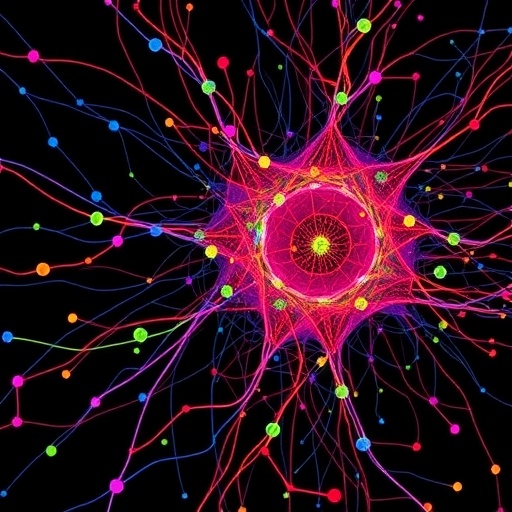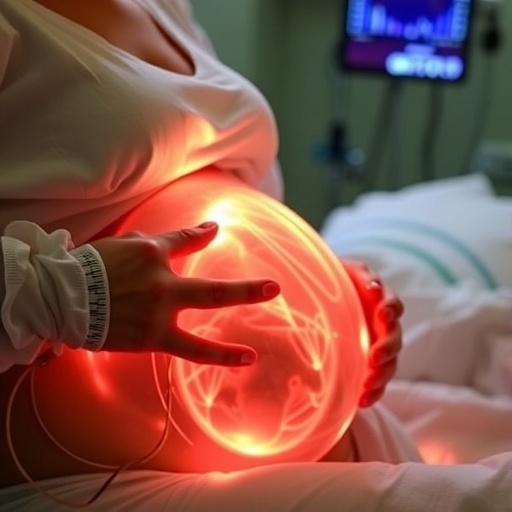
In the rapidly evolving landscape of developmental biology, understanding how cells transition from one fate to another within the complex milieu of a living tissue remains one of the most formidable challenges. Traditional approaches have often treated cell state changes as isolated phenomena, neglecting the intertwined spatial context and temporal dynamics that ultimately govern cellular behavior. Addressing this critical gap, a pioneering study introduces Topological Velocity Inference, or TopoVelo, a novel framework that integrates spatial and temporal dimensions to unravel the dynamic choreography of cell fate transitions using spatial transcriptomic data.
Central to this breakthrough is the recognition that cells do not exist in a vacuum but rather function as part of an interdependent community, influenced by immediate neighbors, diffusible niche factors, and migratory pathways. The classical RNA velocity concept has provided valuable insights by estimating future transcriptional states from nascent and mature RNA abundances within single cells. However, these insights often lacked the spatial contextualization needed to capture how multicellular arrangements influence developmental trajectories. TopoVelo ambitiously extends this framework by embedding gene expression dynamics within spatially coupled differential equations, allowing a holistic view of how gene regulatory changes propagate through tissue space over time.
The innovation of TopoVelo rests on its ability to infer “velocity fields” representing the direction and magnitude of cell state changes across tissues. This is achieved by modeling the continuous gene expression dynamics of thousands of cells collectively rather than treating them as independent entities. Through topological data analysis paired with spatial modeling, the method integrates information from spatial transcriptomic profiles — high-throughput mappings of gene expression preserved in tissue sections — with temporal RNA velocity signals. This fusion marks a significant advance, enabling researchers to track not merely the potential future state of individual cells but to decode how spatial interactions synergize to drive coordinated tissue development.
.adsslot_QiL7GP2HbO{width:728px !important;height:90px !important;}
@media(max-width:1199px){ .adsslot_QiL7GP2HbO{width:468px !important;height:60px !important;}
}
@media(max-width:767px){ .adsslot_QiL7GP2HbO{width:320px !important;height:50px !important;}
}
ADVERTISEMENT
Applying TopoVelo to the developing mouse cerebral cortex, the researchers reveal a rich tapestry of cell velocity vectors mapping onto the brain’s architecture. This approach uncovers spatial dependencies among neighboring cell states that were previously obscured in single-cell analyses devoid of spatial context. Notably, the inferred velocities correlated strongly with the expression patterns of ligand-receptor gene pairs, shedding light on the molecular crosstalk orchestrating neurogenesis. Such findings underscore the potency of TopoVelo in identifying mechanistic links between spatial signaling cues and dynamic gene regulatory regimes guiding tissue patterning.
Beyond the cerebral cortex, TopoVelo’s prowess is further illustrated in its application to the mouse neural tube, a structure essential for central nervous system formation. The framework uncovers spatial signatures indicative of neural tube closure dynamics, a critical morphogenetic event with implications for understanding congenital defects such as spina bifida. These spatial velocity maps reveal coordinated waves of gene expression changes that unfold in a tightly regulated spatial manner, reinforcing the concept that cellular differentiation is tightly integrated with morphogenetic movements and spatial cellular organization.
A significant strength of TopoVelo lies in its applicability across species and experimental systems. Demonstrating this, the research team generated Slide-seq spatial transcriptomic data from an in vitro human developmental model. Utilizing TopoVelo, they dissected how early differentiation events organize within spatial contexts reminiscent of embryonic patterning. This cross-species and in vitro versatility position TopoVelo as a transformative tool, enabling a deeper understanding of conserved and divergent developmental trajectories while providing a platform for dissecting human developmental processes that are otherwise experimentally inaccessible.
From a computational perspective, TopoVelo employs a sophisticated set of spatially coupled differential equations that model gene expression dynamics as a function of both intrinsic regulatory programs and extrinsic spatial neighborhood influences. This approach captures how neighboring cells’ states influence transition rates, enabling the inference of cell “velocity fields” that reveal the synergistic interplay between local cellular microenvironment and intrinsic cellular transcriptional programs. By leveraging advanced mathematical techniques in topology and differential modeling, the method overcomes limitations of conventional velocity frameworks that often treat cells as independent data points.
The implications of integrating spatial context into RNA velocity inference extend far beyond developmental biology. In fields such as cancer biology, regenerative medicine, and tissue engineering, understanding how spatially driven cellular interactions influence fate decisions could unlock new therapeutic strategies. For instance, deciphering how cancer cells co-opt spatial signaling environments to promote metastasis or resistance could inform spatially targeted interventions. Similarly, in regenerative contexts, precision mapping of spatiotemporal gene expression dynamics may enable the design of biomaterials and scaffolds that recapitulate natural developmental niches.
TopoVelo also invites a reconsideration of how single-cell and spatial omics data are integrated. As technologies such as Slide-seq, MERFISH, and spatially-resolved transcriptomics mature, the data deluge demands analytical frameworks attuned to both temporal progression and spatial heterogeneity. The introduction of TopoVelo heralds a paradigm shift, where multidimensional biological data can be fused to reconstruct dynamic cellular decision landscapes in situ. The approach offers a computational blueprint for future analytics aiming to model tissues as intricately connected systems rather than assemblies of isolated cells.
Importantly, the study highlights interpretable features derived from TopoVelo-inferred velocities, linking spatially confined transcriptional programs to functional receptor-ligand interactions. This interpretability bridges the gap between abstract mathematical modeling and biologically meaningful hypotheses, empowering experimental validation. Consequently, TopoVelo serves as both a discovery platform and a hypothesis generator, primed for iterative cycles of modeling and experimentation within spatially structured developmental systems.
The research team behind TopoVelo also provides a glimpse into future directions, emphasizing the integration of additional modalities such as spatial proteomics, imaging mass cytometry, and live-cell imaging data with transcriptomic velocities. Such multimodal fusion could yield even richer dynamic maps of tissue development, embracing the diverse molecular and cellular layers that govern biological systems. Furthermore, scaling TopoVelo to larger tissues and entire organs represents a tantalizing avenue for characterizing complex developmental programs and pathological perturbations.
From an engineering standpoint, TopoVelo’s formalism bears resemblance to physical systems governed by coupled spatiotemporal dynamics, drawing analogies to fluid flows, wave propagation, and reaction-diffusion systems. This cross-disciplinary insight opens avenues for applying well-established mathematical tools from physics and engineering to decode biological complexity, fostering collaborations that transcend traditional disciplinary boundaries. The successful modeling of cell fate transitions as velocity fields is emblematic of this productive convergence.
As the scientific community continues to grapple with the immense complexity of tissue development, frameworks like TopoVelo exemplify the power of computational innovation fused with cutting-edge experimental datasets. By incorporating spatial relationships into temporal gene expression dynamics, the method offers an unprecedented window into the collective cellular decision-making processes. Such holistic insight is poised to accelerate discoveries not only in developmental biology but also in biomedical fields where spatial-temporal coordination is paramount.
In essence, TopoVelo moves the field beyond static snapshots of single-cell states towards a dynamic, spatially informed understanding of cellular trajectories. By modeling tissues as evolving topological landscapes where gene expression flows through spatial domains, researchers gain the ability to visualize and quantify developmental processes at an unprecedented resolution. This conceptual leap promises to reshape how we think about differentiation, morphogenesis, and tissue homeostasis.
The release of TopoVelo arrives at a moment when spatial transcriptomics technology is rapidly maturing but analytical frameworks have lagged behind the data’s richness. This method addresses the pressing need for tools that can connect the “where” and “when” of gene expression changes, providing a unified lens to study biology in situ. It is likely to spark a wave of studies deploying this approach to dissect diverse tissues, developmental stages, and disease contexts, marking it as a foundational advance of the coming decade.
Looking ahead, one can envision TopoVelo being integrated into standard analysis pipelines for spatial omics datasets, complemented by interactive visualization tools that allow researchers to explore inferred velocity fields in tissue contexts. These capabilities will democratize access to complex spatiotemporal dynamics insights, empowering biologists to pose and test novel hypotheses about how cellular communities coordinate to build functional biological structures.
In conclusion, the development of Topological Velocity Inference represents a technological and conceptual milestone, bridging the gap between static spatial maps and dynamic cellular decision-making processes. By modeling spatially coupled gene expression velocities across tissues, TopoVelo sheds new light on the intricate interplay between cellular signaling, migration, and differentiation underlying tissue development. This innovation is set to transform our understanding of biology from the single-cell level to the tissue scale, opening new frontiers in developmental biology, medicine, and beyond.
Subject of Research: Cell fate transitions and spatial-temporal gene expression dynamics in tissue development
Article Title: Topological velocity inference from spatial transcriptomic data
Article References:
Gu, Y., Liu, J., Lee, K.H. et al. Topological velocity inference from spatial transcriptomic data. Nat Biotechnol (2025). https://doi.org/10.1038/s41587-025-02688-8
Image Credits: AI Generated
Tags: cell fate transitionscellular motion analysisdevelopmental biology challengesgene expression dynamicsinnovative biological research methodologiesmulticellular arrangements impactRNA velocity conceptspatial context in biologyspatial transcriptomics frameworktemporal dynamics in cellstissue space interactionsTopological Velocity Inference





